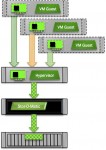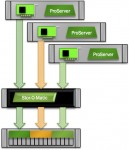Virtualization is a disruptive technology in every sense of the word. By abstracting and simplifying physical resources, virtualization enables dynamic utilization. But this “translation†from physical to virtual disrupts the assumptions that enable performance and flexibility of physical devices such as storage arrays.
Enterprise storage
The I/O Blender Part 1: Ye Olde Storage I/O Path
This old-fashioned, predictable storage I/O path was deterministic and decipherable: The server, the switch, and the array all had enough information to do their jobs effectively and efficiently.
Storage Arrays Do A Few Things Very Well
Storage arrays are big, expensive, and difficult to manage. Plus, concentrating storage in a single device puts everything at risk if there is an outage. So why buy a storage array at all? Arrays do a few things very well, and this often makes up for the difference, on balance.
Link: What’s the Difference Between Compression, Deduplication, and Single-Instance Storage?
The difference between traditional compression and modern data deduplication is somewhat hazy. And it doesn’t help that various implementations fall all along the spectrum from “mildly interesting” to “cutting edge!”
Who Will Support SMB 3.0, and Which Features Will They Support?
I’m really thrilled about the improvements Microsoft is making to the core SMB protocol in Windows Server 2012. But it won’t really matter if nobody but Microsoft supports the new protocol. So I like to call out to all the enterprise storage vendors: Let me hear your support for SMB3.0!



